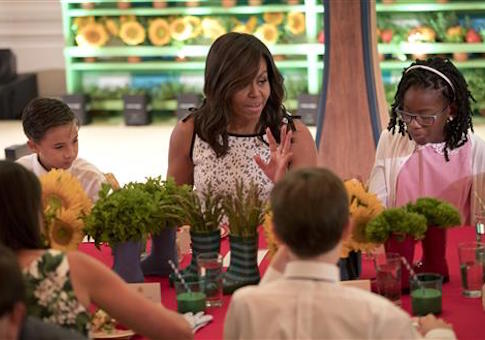The U.S. Department of Agriculture is encouraging middle schoolers to join "School Lunch Advisory Councils" where they learn to "nudge" their peers to eat healthily to comply with First Lady Michelle Obama’s lunch rules.
The agency featured a blog post Thursday by nutrition officials in Montana about how schools are using behavioral economics to create "Smarter Lunchrooms." For example, one school cited in the blog post has put up posters of basketball coaches to get kids to eat apples.
"There are many ways Team Nutrition schools are involving students in the development of school meal menus and health promotion activities," the USDA said. "These activities can help schools offer nutritious foods in a manner that appeals to children and can help students learn about nutrition and school foodservice."
"This guest blog highlights promising strategies for involving students in school meals through the use of School Lunch Advisory Councils," the agency said. "It also describes how Montana students are playing a role in helping their schools implement Smarter Lunchrooms techniques to reduce food waste and increase consumption of healthful foods."
Food waste has increased since more whole grains and less sodium were mandated in school lunches by the Healthy Hunger-Free Kids Act, the law championed by Mrs. Obama that went into effect in 2012.
Now School Lunch Advisory Councils,or SLACs, are being used in Montana middle and high schools to make sure students are eating healthily.
"Food service directors from Montana middle and high schools are enticing teens to choose more fruits and vegetables at school lunch through the use of School Lunch Advisory Councils (SLACs)," the blog post said. "A SLAC is composed of a food service director, an educator, and two to three students that work together toward a goal of implementing simple, low-cost strategies to encourage students to make healthier choices in the cafeteria."
"For example, students from Park High School’s SLAC in Livingston created signage for the school cafeteria to promote fruit selection," the post continued. "This included a life-size poster of the basketball coach giving out an apple with the caption ‘Got fruit? Tastes almost as good as victory.’"
Montana food directors said that once the cafeteria put up the "creative signage" and moved its salad bar, lunch waste decreased by 35 percent.
School lunch officials with the Montana Office of Public Instruction model their cafeterias off the "Smarter Lunchroom Movement" started by Cornell University.
"Smarter Lunchrooms uses the basic principles of behavioral economics (the influencing factors behind people’s choices and behaviors) to create an environment that makes the healthy choice the easy choice," the state agency said.
The program provides tools to "nudge healthy eating as soon as students enter the lunchroom."
Another goal is the "promotion of healthful eating behaviors," which the state agency said is a "cool, new, and positive approach to encourage healthy choices without students knowing it."
